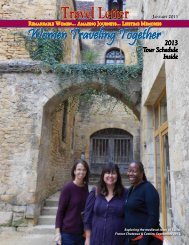July 2013 - Women Traveling Together
July 2013 - Women Traveling Together
July 2013 - Women Traveling Together
You also want an ePaper? Increase the reach of your titles
YUMPU automatically turns print PDFs into web optimized ePapers that Google loves.
16 ◆ july <strong>2013</strong><br />
<strong>Women</strong> <strong>Traveling</strong> <strong>Together</strong> ®<br />
North Carolina Outer Banks ~ April 14-20, <strong>2013</strong><br />
By Tour Leader Christina Smith<br />
Our journey began by crossing the Oregon Inlet which is<br />
spanned by the Herbert C. Bonner Bridge, a 2.7-mile bridge built<br />
in 1963. Prior to this date, ferry service provided the connecting<br />
transportation. Just as we reached the very top of the bridge, we<br />
were greeted by construction workers who brought us to a complete<br />
stop, right at the very top of the bridge! What lucky timing<br />
this was as we were able to watch thousands of cormorants soaring<br />
below us. What a sight.<br />
On Pea Island National Wildlife Refuge, we did our best to<br />
see it all. This refuge includes ocean beach, sand dunes, fresh<br />
water ponds, salt flats and salt marsh. Pea Island is home to more<br />
than 365 species of birds, 25 species of mammals, 24 species of<br />
reptiles and 5 species of amphibians. We saw a lot of turtles! We<br />
especially enjoyed climbing the sand dunes to get to the beach<br />
where we collected shells and marveled at the grandeur of the<br />
ocean. Pea Island Volunteer Earl made himself available to answer<br />
our questions and share his stories. His passion for the area<br />
and his commitment to his volunteer position were very evident.<br />
At Cape Hatteras National Seashore, we learned stories of<br />
devastating storms, shipwrecks, moving a lighthouse and making<br />
a movie. Along its rich history, this special location is a pristine<br />
ocean side wilderness that delights the eye and spirit. Sixtythree<br />
percent of the island is Federal Park land that will never<br />
be developed, while another 14 percent belongs to the state and<br />
another 11 percent is wetlands.<br />
We stopped at the original location of the iconic 1870 Cape<br />
Hatteras Lighthouse and then onto its current location some<br />
1,600 feet from the ocean. The lighthouse was moved (imagine<br />
moving it!) in 1999 because it was threatened by ocean waves.<br />
We had another opportunity to wander the beach collecting sea<br />
shells. Some of us were looking forward to climbing to the top<br />
of the lighthouse for the magnificent view. Unfortunately, the<br />
National Park Service was opening the lighthouse for walks on<br />
April 19 and we were there on April 18. Maybe next time…<br />
During our visit to the Chicamacomico Life Saving Station,<br />
we learned about the tragic sinking of ships and triumphant rescues<br />
conducted by the “surf men.” Known as the “Graveyard of<br />
the Atlantic” because of the many shipwrecks, the Outer Banks<br />
feature especially turbulent conditions where the Gulf Stream<br />
meets the Labrador Currents. The Life Saving Station had displays,<br />
artifacts, photographs, exhibits and video presentations to<br />
educate us about the important role the U.S. Life-Saving Service<br />
played in North Carolina’s Outer Banks. Site Manager James<br />
provided us with an interruptive presentation which helped to<br />
bring all this history to life. The other Site Manager Linda regaled<br />
us with the story of her experience as an extra in the movie<br />
Built in 1975, the Currituck Lighthouse, unlike the more<br />
famous Cape Hatteras Lighthouse, was never painted leaving<br />
its original one million bricks exposed. That’s a lot of bricks!<br />
Nights in Rodanthe which was filmed in this area. She is still filled<br />
with enthusiasm about the experience and took us step by step<br />
through her scene with Richard Gere. The original house (like<br />
the Cape Hatteras Lighthouse) was moved from its location due<br />
to the pounding of the ocean surf, but we tracked it down and<br />
made a stop for photos. It is now used as a bed and breakfast.<br />
We also visited the Elizabethan Gardens on Roanoke Island,<br />
Currituck Lighthouse and much more. Despite being a selfproclaimed<br />
“National Park Junkie” this was my first visit to a<br />
National Seashore. I wasn’t disappointed and now have another<br />
stamp for my National Park Service Passport. I have great<br />
memories from our days spent on North Carolina’s Outer Banks<br />
and my 13 wonderful traveling companions. v<br />
www.women-traveling.com • 1-800-795-7135



